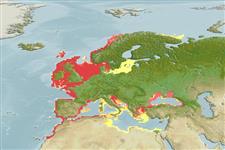Common names from other countries
>
Gobiiformes (Gobies) >
Gobiidae (Gobies) > Gobiinae
Etymology: Aphia: Greek, aphia, -as = a kind of plant (Tussilago sp.) (Ref. 45335).
More on author: Risso.
Environment: milieu / climate zone / depth range / distribution range
Ecologia
marinhas; estuarina; oceanódromo (Ref. 51243); intervalo de profundidade 0 - 97 m (Ref. 57814), usually 5 - 80 m (Ref. 57814). Subtropical; 13°C - 16°C (Ref. 57814); 70°N - 25°N, 13°W - 42°E
Atlantic Ocean: Trondheim to Morocco. Also known from the Mediterranean including Black Sea and the Azov Sea (Ref. 57814).
Comprimento de primeira maturação / Tamanho / Peso / Idade
Maturity: Lm 3.8, range 3 - ? cm
Max length : 7.9 cm TL macho/indeterminado; (Ref. 26260); idade máx. registrada: 1.00 anos (Ref. 232)
Espinhos dorsais (total) : 4 - 6; Raios dorsais (total) : 11 - 13; Espinhos anais: 1; Raios anais : 11 - 15. Transparent body, more or less reddish, with chromatophores along bases of median fins and on head. Vertebrae 26-28 (Ref. 232). Males with longer dorsal and anal fins than females (Ref. 35388).
Benthic and free swimming (Ref. 92840). A neotenic, pelagic species inhabiting inshore and estuarine waters, over sand, mud and eel-grass (Ref. 4343). Adults feed on zooplankton, especially copepods, cirripede larvae and mysids (Ref. 4343). They spawn in summer in empty bivalve shells (Ref. 35388). Probably migrate to deeper water to spawn during summer (Ref. 57814). Adults die after breeding (Ref. 4696) which does not qualify as a manifestation of semelparity but abbreviate iteroparity according to a recent study (Ref. 81039). Eggs are pear-shaped (Ref. 4696).
Single spawner, all oocytes in the ovaries grow at a similar rate (Ref. 57814). However, a recent study showed that this species breeds at least twice during its short lifespan with batches of oocytes at different vittelogenic stages in the ovary (Ref. 81039). Reproduction is of the abbreviate iteroparous type with more than one spawning per reproductive season (in spring and summer in older females, in summer and autumn in the yougner ones) (Ref. 81039).
Maugé, L.A., 1986. Gobiidae. p. 358-388. In J. Daget, J.-P. Gosse and D.F.E. Thys van den Audenaerde (eds.) Check-list of the freshwater fishes of Africa (CLOFFA). ISNB, Brussels; MRAC, Tervuren; and ORSTOM, Paris. Vol. 2. (Ref. 4343)
Status na Lista Vermelha da UICN (Ref. 130435)
CITES (Ref. 128078)
Not Evaluated
Ameaça para os humanos
Harmless
Uso pelos humanos
Pescarias: espécies comerciais
Ferramentas
Relatórios especiais
Baixar XML
Fontes da internet
Estimates based on models
Preferred temperature (Ref.
115969): 7.6 - 18.6, mean 10.8 (based on 1452 cells).
Índice de diversidade filogenética (Ref.
82804): PD
50 = 1.0000 [Uniqueness, from 0.5 = low to 2.0 = high].
Bayesian length-weight: a=0.00525 (0.00458 - 0.00602), b=3.09 (3.05 - 3.13), in cm Total Length, based on LWR estimates for this species (Ref.
93245).
Nível Trófico (Ref.
69278): 3.1 ±0.28 se; based on food items.
Resiliência (Ref.
120179): Elevada, tempo mínimo de duplicação da população menor que 15 meses (K>0.3; tm=1; tmax=1; Fec = 935).
Fishing Vulnerability (Ref.
59153): Low vulnerability (12 of 100).
